#domain name extensions
Explore tagged Tumblr posts
Text
How to Choose a Domain Name for a Professional Website
Before setting up a website, one of the key things to put in place is to choose a domain name that is suitable for your brand, relevant to your business and capable of delivering your expected outcomes. For most beginners, choosing the right domain name can get really daunting and confusing when you do not know how to get started. Apart from cases where one’s preferred domain can get taken up…

View On WordPress
#country code top level domain name#domain name#domain name extensions#Generic top level domain#gTLD#Steps to choose a domain name#TLD#top level domain#top level domain name#what is a domain name
0 notes
Text
i might have bought a domain name.... and started working on a website.... for my gay little knight story..... it might be ready by the end of the month 😳
#s.txt#the last thing is really just deciding where i want to host the website#im building it all myself so thats fun <3 i missed working w html she's like a wife to me#but yeah. shooting for late june/early july to be done w it#my domain name is SO swag.... [REDACTED].quest :) i didnt even know. quest was an allowed extension 😳#anyways <3 so excited. this is the funnest thing ive ever done#might start posting excerpts for REAL this time. because i want people to read the story when i actually do. release it.#if youre a fan of sad stories. tragedy. bad fathers. good fathers. gay men with issues. and of course. people doomed by the narrative. then.
5 notes
·
View notes
Text
5 Reasons Why Choosing the Right Domain Name is Crucial for Your Online Success
In Australia, your domain name is key to your brand’s online success. With over1 700 million domain names out there, finding the right one can seem tough. But, picking the right domain name is crucial for your online success. When I started my business, choosing the domain name was a big decision. It’s a choice that affects my company’s growth every day2. Search engines look at domain names a…
#Digital Identity#Domain Extensions#Domain Name Importance#Domain Naming Strategies#Domain Selection Tips#Online Marketing#Online Presence#SEO optimization#Website Branding#Website Development
0 notes
Text
New Things to Beware on the Internet
On May 3rd, Google released 8 new top-level domains (TLDs) -- these are new values like .com, .org, .biz, domain names. These new TLDs were made available for public registration via any domain registrar on May 10th.
Usually, this should be a cool info, move on with your life and largely ignore it moment.
Except a couple of these new domain names are common file type extensions: ".zip" and ".mov".
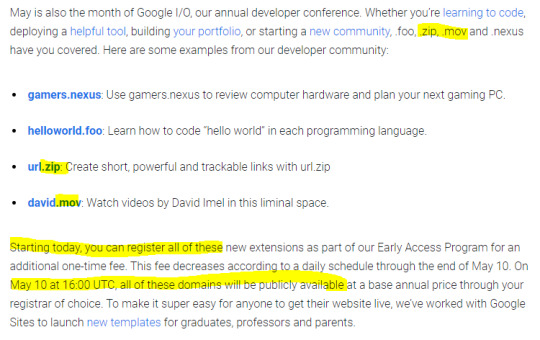
This means typing out a file name could resolve into a link that takes you to one of these new URLs, whether it's in an email, on your tumblr blog post, a tweet, or in file explorer on your desktop.
What was previously plain text could now resolve as link and go to a malicious website where people are expecting to go to a file and therefore download malware without realizing it.
Folk monitoring these new domain registrations are already seeing some clearly malicious actors registering and setting this up. Some are squatting the domain names trying to point out what a bad idea this was. Some already trying to steal your login in credentials and personal info.
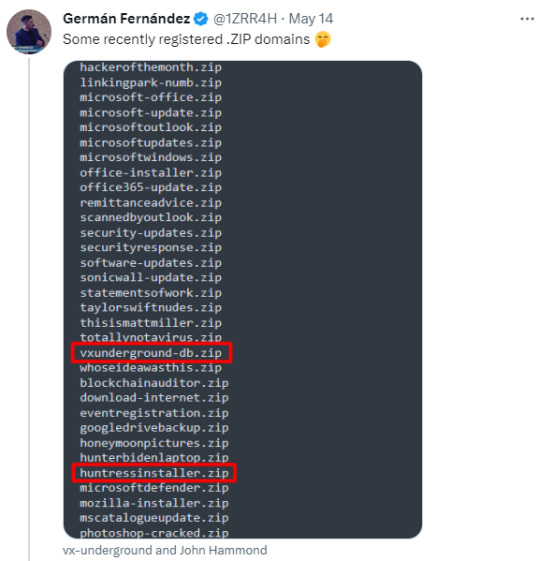
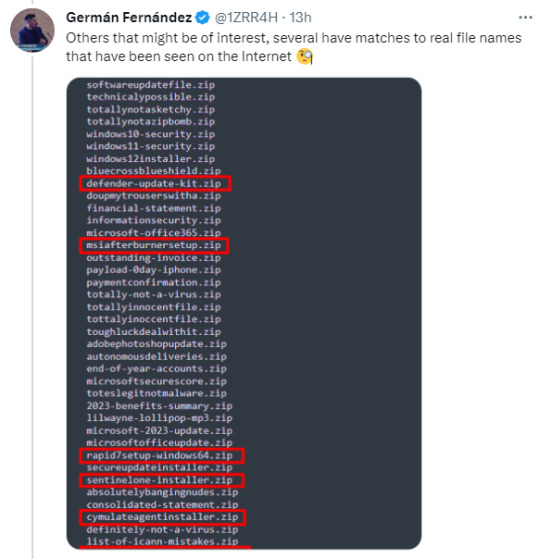
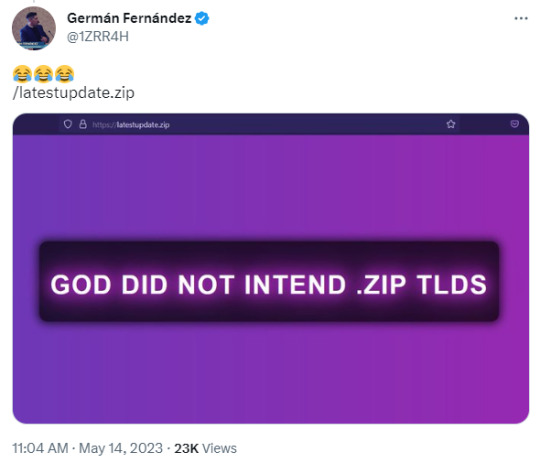

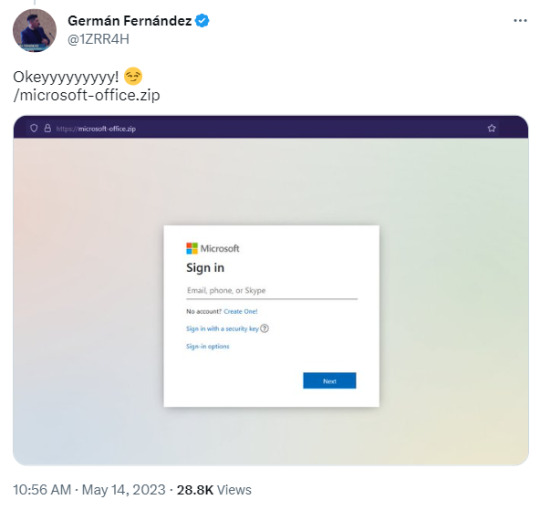
This is what we're seeing only 12 days into the domains being available. Only 5 days being publicly available.
What can you do? For now, be very careful where you type in .zip or .mov, watch what website URLs you're on, don't enable automatic downloads, be very careful when visiting any site on these new domains, and do not type in file names without spaces or other interrupters.
I'm seeing security officers for companies talking about wholesale blocking .zip and .mov domains from within the company's internet, and that's probably wise.
Be cautious out there.
#tech#google#domain names#the more you know#zip#.zip#mov#.mov#yikes#BIG FUCKING YIKES#WHO THOUGHT THIS WAS AGOOD IDEA HOLY SHIT ARE YOU A FOOL
73K notes
·
View notes
Text
Role of DNS in Internet Communication - Technology Org
New Post has been published on https://thedigitalinsider.com/role-of-dns-in-internet-communication-technology-org/
Role of DNS in Internet Communication - Technology Org
Domain Name Systems (DNS) refer to hierarchical and decentralized naming systems for computers, services, and other internet-connected resources. A domain name is translated into an IP address used to communicate between devices. When a user enters a domain into their browser, the browser queries the DNS resolver provided by their ISP. Then, the DNS server converts URLs and domain names into IP addresses that computers understand and use. A user types into a browser and a machine interprets that as a command to find a webpage. This process of translation and lookup is called DNS resolution.
Now we understand what DNS is and how it works, we will talk about the role of DNS in Internet communication.
Data center – illustrative photo. Image credit: kewl via Pixabay, Pixabay license
Visit Websites Quickly
Domain names allow people to access websites much easier than IP addresses. Instead of entering “69.63.176.13” into a web browser, a user can just enter “facebook.com.” The DNS server converts domain names into IP addresses. This enables users to access websites.
Enable Internet connectivity
Internet communication relies heavily on DNS and IP. Without DNS, it would be difficult to remember all IP addresses for the websites we visit daily. DNS gives an easily recognizable domain name that can be used to visit websites. In contrast, IP is in the position of routing data packets between internet-connected devices. It ensures that data packets arrive at their target destination without being lost or damaged along the route. In order to find out what your public IP address is, What Is My IP can be used to check your public IP address, IP location, and your ISP.
Provides Internet Safety
In internet communications, DNS and IP security play an important role in ensuring internet safety. DNS attacks can route visitors to malicious websites, while IP spoofing allows hackers to impersonate devices and obtain unwanted network access. DNSSEC (DNS Security Extensions) and IPsec (IP Security) are two technologies that protect DNS and IP respectively and thus secure communications.
Monitor Network Traffic
DNS and IP are critical components for controlling internet network traffic. DNS servers cache commonly requested domain names to reduce the load on the DNS system and improve response times. On the other hand, IP uses various routing protocols, including OSPF and BGP, to control network traffic and guarantee that data packets are effectively delivered between internet devices.
#browser#cache#command#communication#communications#computers#connected devices#connectivity#data#Data Center#devices#DNS#domain name#domain names#extensions#Facebook#hackers#hand#how#Internet#it#monitor#naming#network#Network Access#Other#Other posts#photo#Play#process
0 notes
Text
DNSSEC: Peace of Mind for Your Online Safety
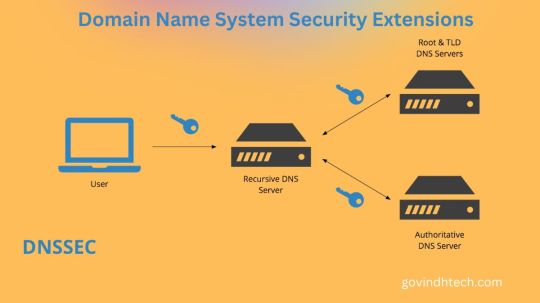
What is DNSSEC?
A feature of the Domain Name System (DNS) that verifies answers to domain name lookups is called Domain Name System Security Extensions (DNSSEC). Although it keeps attackers from tampering with or contaminating DNS query responses, it does not offer privacy protections for those lookups.
Not really. DNSSEC uses a different method than encryption public key cryptography to defend networks from man-in-the-middle attacks. Put differently, Domain Name System Security Extensions offers an authentication method but not a confidentiality method.
DNSSEC: Internet Foundation Protection
Domain Name System (DNS) converts human-readable domain names into machine-readable IP addresses for online security in the digital age. Security issues make traditional DNS vulnerable to manipulation and attacks. DNSSEC safeguards DNS data.
Major Advantages of DNSSEC:
DNSSEC uses public-key cryptography and digital signatures to verify DNS responses. This means a domain name’s IP address is authentic and hasn’t been changed from the authorized source.
Data Integrity: Phishing attempts and malicious website redirects can result from DNS data manipulation. DNSSEC prevents hackers from altering vital DNS records by cryptographically verifying them.
Middleman (MitM) Attack Prevention: DNSSEC guarantees authenticity and data integrity, reducing the risk of MitM attacks, in which attackers intercept and alter DNS responses to trick users.
Domain Name System Security Extensions protects DNS lookups from malicious and tampering, giving users and organizations confidence to use online services.
Is DNSSEC important?
Public/Private Key Pairs: Public keys are published in the DNS by domain owners, while private keys are kept confidential.
Digital Signatures: By digitally signing DNS records with the private key, a “fingerprint” that confirms their legitimacy is created.
Signature Validation: To make sure received DNS records haven’t been tampered with, resolvers the programs that convert domain names into IP addresses verify the signatures using the public key that has been released.
Chain of Trust: Signatures are verified through a chain of trust that originates from the root of trust that is present at the top of the DNS hierarchy.
How to implement DNSSEC
Adoption: DNSSEC is being implemented more often, despite not being widely used. It is supported by a large number of prominent domain registries and registrars, and it is frequently free for organizations to enable.
Benefits Exceed Difficulties: Although DNSSEC setup and configuration may call for some technical know-how, the advantages greatly exceed the drawbacks. Organizations that are concerned about security ought to give it serious consideration for their domains.
What distinguishes public key cryptography from encryption?
DNS queries are digitally “signed,” or authenticated, using public key cryptography by DNSSEC. The receiving device can compare the data it receives with the original data sent by the authoritative server when DNSSEC is enabled on a zone record. A digital signature that authenticates data using public keys makes this possible.
The data in DNSSEC is not encrypted; instead, the authentication keys are secured through cryptography. Traffic protected by Domain Name System Security Extensions can still be intercepted and read. The receiving server will be able to detect that something is wrong if the data is altered somewhere along the data pathway and sent on to its destination because the public keys will not match.
On the other hand, encryption encrypts the data by using cryptography. By altering what an attacker would see if they were to intercept a query somewhere along the data pathway, encryption ensures confidentiality. Until the attacker uses an encryption key to decipher the signal, it renders the data unintelligible. Data is shielded from manipulation by encryption because the key isn’t disclosed to the public.
What is DNSSEC in cybersecurity?
Among the Internet’s more traditional protocols is DNS. The Internet was much smaller when it was first developed, and almost everyone there was acquainted. Data Security was not given much thought.
DNS was used so extensively by then that any major alteration would have brought down the entire system, even before the issue of Internet security arose. Instead of attempting to create a completely encrypted protocol to take the place of DNS, an authentication mechanism was added to the pre-existing system.
DNSSEC was vulnerable. By enabling the authentication of queries and data, it improved protocol security. However, it did so without altering the underlying architecture, allowing the Internet to expand further without requiring any new engineering. Domain Name System Security Extensions deployment was left optional so that organizations could make the switch whenever they felt ready.
If DNSSEC isn’t encrypted, why use it?
One major reason to use DNSSEC is to prevent DNS cache poisoning, also called DNS spoofing. A DNS spoofing attack involves replacing a legitimate DNS query response with an unauthenticated one. After that, the response becomes stuck in the cache, returning the incorrect response and sending users to malicious websites until the “time to live” runs out.
By authenticating DNS responses and guaranteeing that only accurate responses are returned, DNSSEC defends against these types of attacks. DNS spoofing attacks cannot be prevented by encryption, but it may safeguard the underlying data in a DNS connection.
Is DNSSEC still used if it isn’t encrypted?
Sadly, DNSSEC is only used to validate about 20% of Internet traffic. Even though it’s a big improvement over a few years ago, that amount is still far below what it ought to be. That substantial gap can be attributed to a combination of informational gaps, laziness, and usability issues.
By offering a straightforward deployment procedure, NS1 encourages all of its clients to implement DNSSEC. Through IBM’s Dedicated DNS offering- NS1 even offers Domain Name System Security Extensions as a backup provider or redundant DNS option, in contrast to other providers.
Gazing Forward
Security continues to be the primary concern as the internet develops. One of the most important steps toward a more secure DNS ecosystem is Domain Name System Security Extensions. It encourages trust and confidence in online interactions by defending against critical vulnerabilities, protecting users and organizations from malicious activities.
Read more on Govindhtech.com
#technology#govindhtech#technews#news#dns#Domain Name System Security Extensions#ns1#cryptography#DNSSEC
0 notes
Text
Find out the best domain extensions with our comprehensive guide & know which extension is ideal for your online presence.
#what is the best domain extension#what are the best domain extensions#best domain extensions#best domain name extensions#best domain extension for personal website
0 notes
Text
Ionos $1 Domain Names: The Best Deal Anywhere for Your Online Presence
In the world of online business and personal branding, your domain name is your digital identity. It’s the address where your audience can find you on the web. If you’re looking for an incredible deal on domain names, look no further than Ionos. With Ionos $1 domain names, you can secure a professional and memorable web address without breaking the bank. In this article, we’ll explore why Ionos…

View On WordPress
#Affordable Domains#Budget-Friendly Websites#Digital Identity#Domain Deals#Domain Extensions#Domain Registrar#Domain Registration#Ionos $1 Domain Names#Ionos Hosting#Online Business#Online Presence#Personal Branding#Web Address#Web Identity
0 notes
Text
How to Choose the Best Domain Name (6 Tips)
A domain name is basically identified via the internet. It is one of the most important aspects of building a website. A domain name is a unique address for a website that can be accessed through a domain registration. In this, we will discuss what is a domain and how to choose the best domain name for your business or company.

0 notes
Text
What is a Domain Extension ?
Domain Name Extensions are the last part of a domain name. For Example, in ‘gwswebhost.com,’ the domain name extension is .com . We will also see domain name extensions referred to as top- level domains (TLDs). These terms will be used interchangeably throughout the post. Your domain name and domain name extension give you a working domain name that your target audience can type into their browsers to access your website.
There are a few Different types of domain name extensions available :----
Generic Domain Extensions
Sponsored Domain Extensions
Generic - Restricted Domain Extensions
Country Code Domain Extensions
Generic Domain Extensions - There’s a certain irony about the word “generic” in the phrase “generic top-level domain,” or gTLD. Generic means something unexceptional, banal, common – and yet, websites that use a generic top-level domain are respected, sought – after, and valuable to the companies and individuals who use them. gTLDs are the most common TLDs and include .com, .net, and .org. Registering your business using any of these gTLDs gives your website a competitive advantage since they are familiar to users. The Internet Corporation for Assigned Names and numbers (ICANN) manages and maintains the list of gTLDs and occasionally adds new gTLDs to it. The Original seven gTLDs are among the most popular top - level domains on the internet. The Seven are :- .com (Short for Commercial) .edu (Short for Education) .gov (Short for Government) .int (Short for Integer) .Mil (Short for Million) .net (Short for Network) .org (Short for Organization)
Sponsored Domain Extensions - Sponsored top-level domains (sTLDs) are a type or category of top – level domain that is distinguished by the Internet Assigned Numbers Authority (IANA). sTLDs are specialized domain extensions that have a sponsor behind them that represents a specific community that the domain will serve.
Generic - Restricted Domain Extensions - Generic – Restricted Domain Extension is similar to a generic top – level domain, but they are intended for more specific types of websites. When you register this domain extension you will typically need to provide a bit more information about your website and it’s intended purpose. Some examples of this TLD include .name and .pro .
Country Code Domain Extensions - Lastly We have Country - Code Domain Extensions. ccTLDs are domain names for specific Countries, Territories, or States. If a website address ends in a ccTLD, you can usually assume it refers to a specific geographical location. For Example:- .in is used for websites in India, and .co for Colombia, .uk for the United Kingdom. But it’s also used by businesses and Startups the World Over. Each Country has its own TLD that helps to identify that site as being from a specific country. For Example :-
.co (Short for Colombia, but Often used for Company)
.us (Short for United States)
#gws web host#GWSWEBHOST#Domain Extension#domain names#top-level domain extension#domain registration#domain hosting
0 notes
Text
<strong>Domain Name System (DNS)</strong>
New Post has been published on https://bankakredin.com/what-is-domain-name-system-dns-how-dns-works/
Domain Name System (DNS)
What is Domain Name System (DNS)? How DNS Works?
Domain Name System (DNS)
Domain Name System ( DNS ) is a hierarchical naming system distributed over open (WAN) or closed networks (LAN) and built on a database.
The most important feature is that it converts human-readable and catchy domain names (eg: R10.net) to the IP (Internet Protocol) address of the connected network device, allowing the world to find and connect the relevant device.
DNS is a system responsible for the translation of a domain name to its IP address in the global database.
In the early days of the Internet, it was easy for people to remember their respective IP addresses because of restricted IP addresses. However, after a while, it became difficult to remember these IP addresses. As the number of servers and clients in the network increased, it became increasingly difficult to operate with IP addresses in mind. Even if it is possible to reach a site that you already know its IP address directly with its IP address, DNS is of great importance today.
The emergence of DNS
In order to link these domain names and IP addresses together in the early days of the Internet, Elizabeth Feinler of Stanford defined a file named “hosts.txt” with IP and domain name matches for each computer connected to the Internet . When this situation started to become insufficient with the growth of the internet day by day, in 1983, USC (University of Southern California) research assistant named Paul Mockapetris was assigned to solve this problem. The solution was a solution called DNS that we use today .
Today, DNS standards are set by the Internet Engineering Task Force (IETF) .
How do DNS servers work?
DNS directories are distributed worldwide and are stored on specialized servers called DNS servers (DNS servers) that communicate with each other.
DNS servers store and present information to clients that map a domain name to one or more IP addresses.
When the client tries to go to a domain address, the DNS server, which is at the optimum distance to the person, directs the relevant request to the IP address and the client accesses the device related to the domain name. With DNS caching, this process can be optimized and performance can be increased.
domain name system,domain name system (dns),domain name system definition,what is the function of the domain name system (dns),explain domain,name system,what is domain name system in computer network,the domain name system is maintained by,domain name system example,domain name system security extensions,types of domain name system,dynamic domain name system,domain name system attack,domain name system adalah,domain name system architecture,domain name system advantages,domain name system and domain name server,domain name system and ip address,domain name system advantages and disadvantages,domain name system application layer,domain name system active directory,
#domain name system#domain name system (dns)#domain name system active directory#domain name system adalah#domain name system advantages#domain name system advantages and disadvantages#domain name system and domain name server#domain name system and ip address#domain name system application layer#domain name system architecture#domain name system attack#domain name system definition#domain name system example#domain name system security extensions#dynamic domain name system#explain domain#name system#the domain name system is maintained by#types of domain name system#what is domain name system in computer network#what is the function of the domain name system (dns)
0 notes
Note
Hi, I love your works!! I was wondering where you find the original, unedited pictures you use for your art? Do you take them yourself or find them online?
Hey there! I get them from many different sources! Whenever I can I use my own, and sometimes my followers send me cool pics to use (or put them up in the Sacrificial Altar channel in my Discord), but I find most of what I use through public domain sources online!
For the online part, I put this little list together with some of the common resources I use! Feel free to share it around and copy it:
For an easier experience, I'll copy the relevant part below:
STOCK SITES
- Unsplash: Usually the best quality out of the free stock sites. They’ll try to sell you a subscription plan but you can ignore that.
- Adobe Stock: Select “Free” on the dropdown menu next to the search bar. The free image selection here is big and high-quality, though they feel more like stock pictures than natural photos. Note: They limit how many pictures you can download per account per day, but you can make several accounts to circumvent this if you use it a lot.
- Texturelabs: lots of free, very high-quality textures!
- Pexels: Similar to Unsplash, but it has more pictures with people. If you need a photo with models, this is usually the best place.
- Pixabay: Widest selection, but worst quality control. Go here if you haven’t found anything in other sites and don’t mind sifting through a bunch of garbage pics and occasional AI images.
PUBLIC DOMAIN SOURCES
- Wikimedia Commons: an enormous selection of CC and public domain pictures. Super useful, especially for the really specific images that you'd expect to find on a Wikipedia article. Always check the copyright conditions! To filter by license, search something and then click on the License dropdown under the search bar. Select “No restrictions” for public domain images.
- Picryl: A repository of public domain sources, ranging from ancient historical books and artifacts to fairly modern pictures. If you're looking for something old/historical, chances are it's here! This website is probably one of the most complicated ones to use, so here are three important tips before you use it:
This site added a paywall that appears after the 3rd page of search results. To remove it, install uBlock Origin, go to the “My Filters” page (clicking on the gear icon after opening the extension), and paste this filter: picryl.com##._9oJ0c2
After searching, use the timeline on the top right to narrow down the result by year.
It won’t let you download the full picture without paying, but it always has a link to the source site below the description. Click on that, then copy-paste the image’s name to find it in the original source. That way you can get it for free, and often in better quality than Picryl offers.
National Archives Catalog, The Library of Congress, NASA, and Europeana have wide selections, but they are included in Picryl so it’s usually better to search there and then download them in the source as mentioned above!
- Flickr Search: a ton of usable pictures with a generally more amateur feel, just remember to filter by license using the “Any license” dropdown menu. When you find an image, make sure to check its specific license (you can find it below the image, on the right side).
- Openverse: The official Creative Commons archive, has many sources! Includes other sites on this list, but has a lot of clutter if you don’t filter.
- iNaturalist: a repository of user-submitted images of animals, plants, and fungi. Look for a genus or species, then navigate to the photo list and filter by license.
MUSEUM COLLECTIONS
- The Met: An amazing selection of artifacts from all over the world, with top quality photographs of most of them (usually with several angles for each). You can filter images by material, location, and era.
- Getty Museum: Another smaller selection of museum pieces, but this one includes old photos as well as artifacts. You can also filter by dates, materials and cultures. Make sure you include the “Open Content” filter to only see public domain things!
- Smithsonian: Big selection of around 5 million museum pieces, with some 3D scans of museum pieces. Most pieces just have a single picture that can sometimes be low quality, but pieces with 3D models sometimes also include a lot of high quality photos from multiple angles. This collection also includes things from museums of natural history, so you can also use it to search for bones and specimens.
- Artvee: public domain classical art. They make you pay to download high-quality images.
If you guys got any others, please let me know and I'll add them to the collection!
149 notes
·
View notes
Text
previous | how far can we go? — twelve | next
a/n: finally out of the attic you guys 😭

if kinich hadn’t had his digital watch, he would have lost count of how many hours the team had really spent in the dark, dingy dungeon. it had been about a day, to be precise, but time seemed to be standing still in this ruin. it was a jolly team of adventurers, really, and all of them seemed very enthusiastic about exploring this dangerous domain. they bore the crest of tlalocan on their attire, shining soft red under the warm light of the flames of the brazier they were currently camping next to.
“i remember when aphila tried to ride her qucusaur for the first time— she fell right onto her butt!”
“that was so long ago! you still remember that?!”
“it would’ve been great if we had chuychu join us. her medical ability truly is something else.”
kinich recognises the name— chasca’s sister. he’d heard that she was particularly skilled in cleansing abyssal energy. not a very easy feat to achieve, no doubt. the group recalling anecdotes of their friendships from years past triggered kinich’s recollection of his own memories of commissions. it’s funny how one begins to reflect upon the course of their life only in moments that they perceive to be their last.
many believe that kinich is someone who only cares for mora, and has an all or nothing approach to his work, and by extension, to his life. kinich’s reserved nature can lead people into believing that he does not care for personal relationships. but it does not matter to him, he thinks to himself. he does not need to prove anything to anybody.
that being said, his ‘reputation’ is also the reason people do not usually find him approachable for anything other than work. it is fairly reasonable, but it gets a little lonely, sometimes. it’s alright though, kinich is used to the loneliness. he’s been on his own ever since his father tumbled to his death down a cliff. although, one could say he has had a taste of this life even before his father’s untimely death.
this might be the reason that kinich takes his work as seriously as he does. after everything that life has thrown at him, he realises that his worth in mora is the most important of all. he hasn’t had anyone to go back home to after that fateful day, but he likes to think he would prove himself useful to the people he loves by putting a dinner on everybody’s plates.
until one day, a certain someone came along and realised his need to prove useful to people. she lulled him with sweet words and reassurances and soft kisses in the moonlight. and this certain someone would eventually leave him in doubt in the exact same vein. he has questioned himself about it since then, and to this day he believes that this certain someone left him in the dust for another man because he was not enough. of course, as a result of this, kinich does not inherently try to be ‘useful’ to anyone outside of his commissioners, and he accepts that he would pay the price for it with his limited number of relationships.
and then mualani and kachina came along, and they were simply happy to have him around as just friends. not as a commissioner. admittedly, it was a first for kinich. “you don’t have to pay me, i just did what i thought was right,” he turned kachina away after he taught her bullies a lesson they were sure to remember for the rest of their lives. but he remembers that kachina is still a little child, and adds as a consolation— “... but if you ever require it, you can always call upon me.”
the morale within the team has considerably declined, and no one is talking much anymore. more and more people start remarking about how anxious they are, and everyone tries to console each other.
when kinich first accepted mualani’s commission, he’d assumed that she simply had all the money in the world to frivolously spend on a small commission like this. he did slightly judge her decisions, because all that money could have been spent better elsewhere - but he was not going to complain, it was getting him better dinners on those days than his usual grainfruit meals. it took him a while, but the two of them eventually became friends, according to mualani at least. “is going from taking my ludicrous commission money to advising me on how to properly price my commissions not a sign of progress?” her words ring in his ears and he swears he can hear her grin.
aphila and two others have decided to drop out. their hearts can’t take the anticipation of traps in every room they encounter anymore. the leader tells them that it’s alright, that they are free to turn back and that he wouldn’t hold it against them. the three of them, grateful, express their thanks and leave after a tight embrace and wishes for the safety of everyone else.
how kinich knew you, was no different from the others. he knew you because of the commissions you placed. you were a peculiar one, though. your commissions were never highly priced, but you did always offer to cook him a nice meal every time he took one. he always turned you down though, but you never took your offer back. kinich takes this to think that you possibly think of him as a friend, too. he wouldn’t be surprised, considering that you had a mindset similar to kachina and mualani.
perhaps he should’ve taken you up on that meal sometime (he thinks that he might now consider you a friend as well, too late), before potentially sending himself to his doom in this domain. it’s not that he was scared of dying, but he can’t deny that the thought of it would make anybody anxious, even a little bit. but this risk is what comes with his line of work, and there is nothing he can do about it. if anything, kinich realises that he has regrets, particularly regrets that pertain to his relationships, and you.
at this point, kinich, the leader, and three others are the only people who have continued on. after aphila, the others started gradually dropping out. the leader’s morale never wavered once, or so kinich thought, until they descend further once more. the leader slumps down on the floor, huffing. “i… i do not think i can do this anymore, mr. kinich.”
kinich doesn’t feel right to coerce him into continuing. after all, human lives are more important than mora— something he has come to realise with the course of time, a principle that he applies to everyone except himself. “understood. i will carry the mission forward until it is complete.”
the leader looks surprised. he adjusts his hat and looks up at kinich, tiredness evident on his astonished face. “you shouldn’t have to do this alone, you know? you can go back with us, we will still pay you the full amount that we agreed on.”
he understands. but he does not feel it right to take the pay for a commission that he failed. and besides, he was interested in this ruin of his own accord, but that was secondary. kinich is also aware that in the event of his death, these people from the flower feather clan would possibly be held responsible. “i cannot agree with taking the pay for an unfinished job. however, i can promise you that i will see this domain through, and i will return alive. i hope that is enough consolation for you.”
after what feels like a long moment of rumination and negotiation, the remainder of the squad turns around, and kinich continues on into the darkness, alone. after all, what is a life without risks? and what use would he be of, if he could not finish the job? he keeps going, until he reaches what he can only presume to be the bottom of the domain, the probable exit guarded by a shadowy figure lurking in the dark.

taglist !
@yuriisclumsy @fandomfan-102 @jiminscarmex @keiiqq @blaxvoid @eunchaeluvr @just-simping-over-genshin @kuniz-darlingg @sugacor3 @help-whatdoimakemyusername @yomsy @kunichio
[please send me an ask or DM if you would like to be added ♡]
69 notes
·
View notes
Text
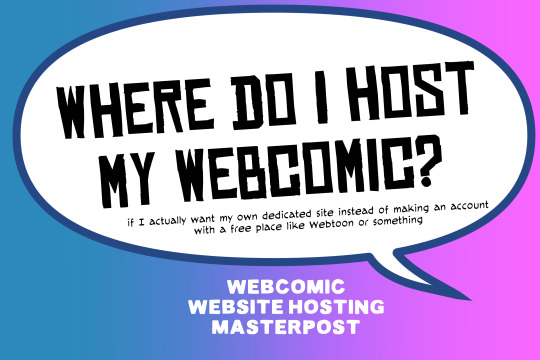
There are many web hosting companies to choose from if you're taking the plunge into making your own website with a comic content management system (CMS) like ComicControl or Grawlix, a Wordpress comic theme like Toocheke or ComicPress, or a HTML template to cut/paste code like Rarebit. While these solutions are generally free, finding a home for them is... generally not. It can be hard to choose what's best for your webcomic AND your budget!
We took a look at a few of the top hosting services used by webcomics creators using webcomic CMSes, and we put out a poll to ask your feedback about your hosts!
This post may be updated as time goes on as new services enter the hosting arena, or other important updates come to light.
Questions:
💻 I can get a free account with Wix/Squarespace/Carrd, could I just use those for my comic? - Web hosts like this may have gallery functions that could be adapted to display a series of pages, but they are very basic and not intended for webcomics.
📚 Wait, I host on Webtoon, Tapas, Comic Fury, or some other comic website, why are they not here? - Those are comic platforms! We'll get into those in a future post!
🕵️♀️Why does it say "shared hosting"? Who am I sharing with? - "Shared hosting" refers to sharing the server space with other customers. They will not have access to your files or anything, so it is perfectly fine to use for most comic CMSes. You may experience slowing if there is too much activity on a server, so if you're planning to host large files or more than 10 comics, you may want to upgrade to a more robust plan in the future.
Web Host List
Neocities

Basic plan pricing: Free or $5/month. Free plan has more restrictions (1 GB space, no custom domain, and slower bandwidth, among other things)
Notes: Neocities does not have database support for paid or free accounts, and most comic CMS solutions require this (ComicCtrl, Grawlix, Wordpress). You will need to work with HTML/CSS files directly to make a website and post each page.
Hostinger

Basic plan pricing: $11.99/month or $7.99/month with four year commitment (monthly, 1, 2, and 4 year plans available).
Notes: Free domain for the 1st year. Free SSL Certifications. Weekly backups.
KnownHost

Basic plan pricing: $8.95/month or $7.99/month with four year commitment (monthly, 1, 2, and 4 year plans available).
Notes: Free DDOS protection. Free SSL Certifications.
InMotion Hosting

Basic plan pricing: $12.99/month or $9.99/month with three year commitment (monthly, 1, and 3 year plans available).
Notes: Free SSL Certifications, free domain names for 1 and 3 year plans. 24/7 live customer service and 90-day money-back guarantee. Inmotion also advertises eco-friendly policies: We are the first-ever Green Data Center in Los Angeles. We cut cooling costs by nearly 70 percent and reduce our carbon output by more than 2,000 tons per year.
Reviews:
👍“I can't remember it ever going down.”
👍“InMotion has a pretty extensive library full of various guides on setting up and managing websites, servers, domains, etc. Customer service is also fairly quick on responding to inquiries.” 👎“I wish it was a bit faster with loading pages.”
Ionos Hosting

Basic plan pricing: $8/month or $6/month with three year commitment (monthly, 1, 2 and 3 year plans available).
Notes: Free domain for the first year, free SSL Certification, Daily backup and recovery is included. Site Scan and Repair is free for the first 30 days and then is $6/month.
Reviews:
👍“Very fast and simple” 👎“Customer service is mediocre and I can't upload large files”
Bluehost

Basic plan pricing: $15.99/month or $4.95/month with three year commitment (monthly, 1, 3 year plans available).
Notes: Free domain and SSL certificates (for first year only). 24/7 Customer Service. Built to handle higher traffic websites. Although they specialize in Wordpress websites and provide updates automatically, that's almost a bad thing for webcomic plugins because they will often break your site. Their cloud hosting services are currently in early access with not much additional information available.
Reviews:
👎"The fees keep going up. Like I could drop $100 to cover a whole year, but now I'm paying nearly $100 for just three months. It's really upsetting."
👎"I have previously used Bluehost’s Wordpress hosting service and have had negative experiences with the service, so please consider with a grain of salt. I can confirm at least that their 24/7 customer service was great, although needed FAR too often."
Dreamhost

Basic plan pricing: $7.99/month or $5.99/month with three year commitment (monthly, 1, 3 year plans available).
Notes: Free SSL Certificates, 24/7 support with all plans, 97-day moneyback guarantee. Not recommended for ComicCtrl CMS
Reviews:
👍“They've automatically patched 2 security holes I created/allowed by mistake.” 👍“Prices are very reasonable” 👎 “back end kind of annoying to use” 👎 “wordpress has some issues” 👎 “it's not as customizable as some might want“
GoDaddy

Basic plan pricing: $11.99/month or $9.99/month with three year commitment (monthly, 1, 2, and 3 year plans available).
Notes: Free 24/7 Customer service with all plans, Free SSL Certificates for 1 year, free domain and site migration.
Reviews:
👍Reasonable intro prices for their Economy hosting, which has 25GB of storage 👍Migrated email hosting service from cPanel to Microsoft Office, which has greater support but may not be useful for most webcomic creators. 👎 Many site issues and then being upsold during customer service attempts. 👎 Server quality found lacking in reviews 👎 Marketing scandals in the past with a reputation for making ads in poor taste. Have been attempting to clean up that image in recent years. 👎 “GoDaddy is the McDonald's of web hosting. Maybe the Wal-Mart of hosting would be better. If your website was an object you would need a shelf to put it on. You go to Wal-Mart and buy a shelf. It's not great. It's not fancy. It can only hold that one thing. And if we're being honest - if the shelf broke and your website died it wouldn't be the end of the world.The issue comes when you don't realize GoDaddy is the Wal-Mart of hosting. You go and try to do things you could do with a quality shelf. Like, move it. Or add more things to it.” MyWorkAccountThisIs on Reddit*
Things to consider for any host:
💸 Introductory/promotional pricing - Many hosting companies offer free or inexpensive deals to get you in the door, and then raise the cost for these features after the first year or when you renew. The prices in this post are the base prices that you can expect to pay after the promotional prices end, but may get outdated, so you are encouraged to do your own research as well.
💻 Wordpress hosting - Many of the companies below will have a separate offering for Wordpress-optimized hosting that will keep you updated with the latest Wordpress releases. This is usually not necessary for webcomic creators, and can be the source of many site-breaking headaches when comic plugins have not caught up to the latest Wordpress releases.
Any basic hosting plan on this list will be fine with Wordpress, but expect to stop or revert Wordpress versions if you go with this as your CMS.
🤝 You don't have to go it alone - While free hosts may be more limited, paid hosting on a web server will generally allow you to create different subdomains, or attach additional purchased domains to any folders you make. If you have other comic-making friends you know and trust, you can share your server space and split the cost!
Want to share your experience?
Feel free to contribute your hosting pros, cons, and quirks on our survey! We will be updating our list periodically with your feedback!
123 notes
·
View notes
Text
Domain Name Valuation: Assessing Value Using Key Factors and Tools - Technology Org
New Post has been published on https://thedigitalinsider.com/domain-name-valuation-assessing-value-using-key-factors-and-tools-technology-org/
Domain Name Valuation: Assessing Value Using Key Factors and Tools - Technology Org
The digital era has given rise to the prominence of domain names, often considered the internet’s real estate. Just as with tangible properties, the valuation of these domains is critical, especially as businesses strive for online identity, credibility, and visibility. This article delves into understanding domain name valuation, shedding light on the techniques and tools available to gauge the worth of a domain name. By grasping these concepts, stakeholders can make informed decisions in buying and selling these invaluable digital assets.
Choosing a suitable domain name is important for every business. Image credit: Igor Miske via Unsplash, free license
Why Domain Name Valuation Matters
In today’s interconnected world, a domain name is not merely an address on the internet; it’s a brand’s identity, a tool for search engine optimization, and a pivotal factor in business visibility. Let’s explore some reasons why domain name valuation holds paramount importance:
Branding. A unique and catchy domain name enhances brand recall, solidifying its position in the market. For instance, domains like “Amazon.com” or “Google.com” are synonymous with their services.
SEO Impact. Search engines consider domain names while ranking websites. A relevant domain can boost SEO, leading to better search engine visibility and increased organic traffic.
Business Transactions. Like any valuable asset, domain names are bought, sold, or even held as an investment. Proper valuation ensures fair transactions, preventing stakeholders from underselling or overpaying.
To further comprehend the significance of domain name valuation, consider the following key factors:
Domains related to ongoing market trends or emerging technologies may witness a surge in value.
Top-level domains (TLDs) like .com or .org are often perceived as more valuable than newer or niche extensions.
A domain free from trademark disputes or litigations will naturally have a higher valuation.
Key Factors Influencing Domain Name Value
Understanding the components that contribute to a domain’s value is essential. These factors serve as a guide for potential buyers or sellers in the domain market.
Length of the Domain
Shorter domain names, especially those with fewer characters, are typically more valuable because they are easy to type and remember and less prone to typographical errors. For instance, domains like “fb.com” or “go.com” are more desirable than longer, cumbersome domain names.
Keyword or Phrase Relevance
Popular or industry-specific keywords can significantly enhance a domain’s value. A domain like “BuyShoes.com” holds more value for a footwear retailer than a vague or unrelated domain name. This relevance can lead to better organic search rankings and increased traffic.
Commercial Potential
A domain that resonates with a product, service, or industry has high commercial potential. Its monetization ability through eCommerce, advertising, or as a premium domain in a specific industry niche can lead to higher valuations.
Historical Sales Data
Past sales data provides insights into market trends and the potential worth of similar domains. For example, suppose a domain with an identical keyword or structure has fetched a high price in a recent sale. In that case, it can indicate the current market value for analogous domains.
Tools for Domain Name Valuation
In the ever-evolving landscape of the internet, having the right tools to answer the question “What is my domain name worth?” can make the process of domain valuation both efficient and accurate. Whether you’re a domain investor looking for your next purchase, a business aiming to rebrand, or an individual assessing the worth of a domain you already own, understanding the tools available is crucial. Considering many factors, these instruments range from automated platforms offering instant appraisals to manual methods.
Automated Appraisal Tools
With technology at our fingertips, several platforms provide instant domain valuations based on algorithms and extensive data:
One of the most renowned platforms in the domain industry, EstiBot utilizes data from millions of domain name sales to offer its appraisals. It not only provides a valuation but also gives insights into related domain sales and potential end-users.
GoDaddy Domain Appraisal
Leveraging an extensive database of domain sales and using machine learning, GoDaddy offers a domain valuation tool that gives an estimated market value, comparable sales, and other related data.
These automated tools are convenient and provide quick insight, but it’s essential to note that they should be used with other methods for a holistic view.
Manual Appraisal Considerations
While automated tools offer a starting point, manual appraisal provides a more in-depth analysis. When manually assessing a domain’s worth, consider the following guidelines:
Traffic and Revenue. A domain receiving high organic traffic or generating significant revenue holds more value.
Linguistic Value. Simple, easily spelled, and pronounceable names in major languages are more valuable.
Market Potential. Assess if the domain can tap into a larger market or niche. Domains relevant to thriving industries or trends can demand higher prices.
Historical Relevance. A domain with a reputable history, devoid of any malicious activities, is more attractive to buyers.
Comparative Sales Analysis
Comparing a domain with similar past sales can offer valuable insights into its potential market value. Platforms like NameBio provide a database of historical domain sales. By inputting keywords or domain structures, users can access data on how much similar domains have sold for, helping guide pricing decisions.
Conclusion
Domain names, the gateways to the digital realm, play a pivotal role in shaping online identities and business ventures. Accurately valuing these assets is crucial in the ever-competitive internet landscape. By harnessing the power of both automated tools and manual appraisal methods, stakeholders can ensure they’re making informed decisions, be it in buying, selling, or understanding the potential of a domain. As the digital era continues to expand, the importance of domain name valuation is only set to increase, making the knowledge of its intricacies invaluable.
#advertising#Algorithms#Amazon#Analysis#Article#assets#automated tools#Branding#Business#data#Database#domain name#domains#easy#emerging technologies#engine#engines#extensions#factor#Fintech news#gateways#Google#History#how#identities#identity#Industries#Industry#InSight#insights
0 notes
Text
Mythology Fact #1 - Sobek, Egyptian Crocodile God
NEW SERIES! Mythology Facts will explore many elements of world mythologies, but with a particular focus on Greek, Egyptian, and Norse, especially at the start.
Easily the winner of the first poll about this new series as held on my Patreon is Sobek, the ancient Egyptian crocodile-headed god!
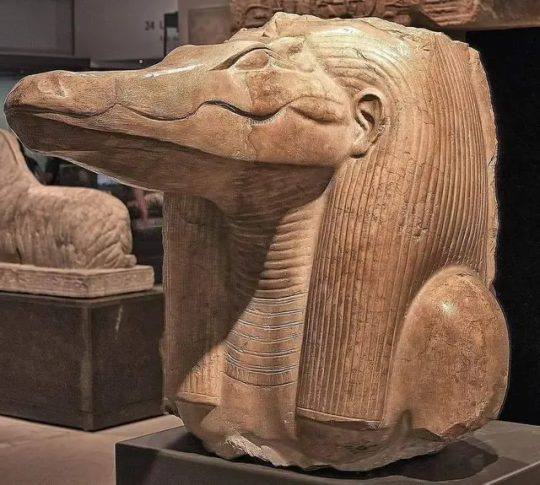
Head of a limestone statue of Sobek, as previously on display at the Met as part of a special collection; Met info on the statue head here
In ancient Egypt, like many ancient cultures, the most fearsome of beasts were highly regarded for their awe-inspiring endurance, power, and ferocity - a concept often little-understood today, as animals are now often seen as obstacles to be conquered or put out of the way, hence why it can occasionally be difficult to detail to the modern mind the relationship between men and wolves throughout history (but I'm not on that right now, so I'll stop). The people of ancient Egypt held great reverence for many animals, not least among them being the obviously very dangerous crocodile.
An integral part of life in ancient Egypt was the rise and fall of the Nile. Sobek was a centerpiece of the Nile life - crocodiles were abundant, a testament to their fertility and virility, and they were fearsome, strong, and enduring. Sobek's nature is intensely complex and his "domains," as we so often think of deities as having, were extensive, including but not limited to fertility, virility, illness, health, strength, pharonic power, military might, protection (especially protection from, essentially, bad luck), and the dangers and wonders of the Nile. By nature, he was considered animalistic, unpredictable, strong, protective but dangerous, and highly sexual, aspects frequently associated with the most powerful predators in a given region (notice all those things are also associated with wolves). Sobek was depicted variably as a crocodile and a crocodile-headed man, and holy crocodiles were kept in his name.
Given his association with the Nile and so many other things, Sobek was and mostly remained a very important figure, especially with his later fusion with/association with both Horus and Ra, two extremely important deities...
This is quite the lengthy post! More under the cut.
Among many other things, Sobek was said to have power of the fertility of the Nile's soil, as well as its waters, and thus also had great power over disease, as the Nile could also cause illnesses. Like so many ancient Egyptian deities, Sobek also had an association with the dead, being called upon to bring them sight and return their senses in the afterlife, as well as to assist in protecting them (along with many other deities, including but certainly not limited to Isis, Nephthys, and Anubis).
Sobek's strong association with fertility is found in his many epithets and even the name we use for him most - "Sobek" is thought to perhaps even come from a causative of "to impregnate" (though some scholars contend it instead means "to unite," especially in relation to the pieces of Osiris). Perhaps the first instance we have of Sobek in a text comes from the Pyramid Texts, in which a spell refers to Unis (the pharaoh) as a living incarnation of Sobek - the pharaohs were very often living incarnations of assorted deities at various times - and says that Unis "will copulate" very specifically and that he is the lord of something that would probably get this post censored, "who takes women from their husbands to the place Unis likes according to his heart's fancy."

Mummified crocodiles found in the Temple of Kom Ombo; we have found mummified crocodiles of all ages, even including fertilized eggs
Now let's talk about a thing called the petsuchos. Mummified crocodiles served as images of Sobek in various forms, one of which being Petsuchos, meaning "son of Sobek." It is thought one crocodile in particular took on the aspect of the petsuchos and was kept in Shedet, replaced by a new petsuchos whenever the previous died. Following the death of a holy crocodile, a great ritual took place to mummify the creature and then put it on display, as it remained ever sacred. Living crocodiles were sometimes kept in other temples and holy places, even including outdoor pools. They were adorned with gems and fed delicacies; some were even considered attractions, as feeding the holy crocodile brought good luck, given Sobek's apotropaic nature. There was even a divine crocodile breeding center established by Amenhotep III (who pushed the Sobek cult quite energetically).

There are many depictions of Sobek found throughout what we have of ancient Egypt, including many of its time periods. He is perhaps one of the oldest gods of ancient Egypt, having appeared as early as during the reign of King Narmer in the first dynasty. His importance during the Old Kingdom, as well, can be found in the Pyramid Texts. The entire region of Fayum was a cult center of Sobek, so great was his importance, the seat of which was - of course - the capital, Crocodilopolis or Shedet.
Also very worthy of note is Sobek-Ra, a combination of the gods Sobek and Ra, that appeared in very late-age Egypt in the New Kingdom (1150-1069 BC), and even continued into the Ptolemaic Period (around 332 BC to 390 AD). Sobek-Ra (or Sobek-Re if you want to go that way) may have first appeared during the reign of the first king of the Middle Kingdom, Montuhotep II, as addressed in the Coffin Texts used during the Middle Kingdom (in which Sobek is addressed as "he who rises in the east and sets in the west"). As a combination, depictions thereof often had the head of a falcon but the body of a crocodile, often wearing the solar disc and uraeus (cobra).
He combined aspects of both deities, which is also perhaps thanks to Sobek's association also with Horus. When Horus took on the aspect of a crocodile during his retrieval of Osiris's bodyparts, Sobek became associated with him, even considered an aspect of Horus. Likewise, however, Sobek also was said to have assisted Isis during Horus's birth. Such deity fusions, aspects, and deities becoming an aspect and/or appearing in various myths in nebulous forms were not uncommon in ancient Egypt, and Sobek was also combined with Horus at assorted other points. All of this continues to point to the association between Sobek and kings (pharaohs), especially when you reach the point of learning about Sobek of Shedet-Ra-Horus, but I won't go into all that here due to time constraints.
So, obviously, there's so much more to say that it's, frankly, crazy and almost overwhelming. The study of ancient Egypt is a complex undertaking, hence why we have an entire field called Egyptology. So, consider this very much a simplified overview. Hope you enjoyed the post!
And stay tuned for news and updates on a major [werewolf/fantasy/adventure/horror/epic] book release later this year! Likewise, if you enjoy mythology in general and Egyptian myth, be sure to check out my other works of fiction, including this one here--also available on Amazon.com and many other retailers. Sequel coming next year.
If you like my blog, be sure to follow me here and elsewhere for much more folklore and fiction, including books, especially on werewolves! You can also sign up for my free newsletter for monthly werewolf/vampire/folklore facts, a free story, book previews, and my other sundry projects and works.
Free Newsletter - maverickwerewolf.com (personal site + book shop) — Patreon — Wulfgard — Werewolf Fact Masterlist — Folklore Fact Masterlist — Mythology Fact Masterlist — X — Vampire Fact Masterlist — Amazon Author page
#mythology#myth#egyptian myth#egyptian mythology#ancient egypt#egypt#crocodile#crocodiles#the nile#nile#sobek#folklore#legend#egyptian deities#egyptian gods#mythology fact#history#egyptian history#research#fiction#Wulfgard#long post
58 notes
·
View notes